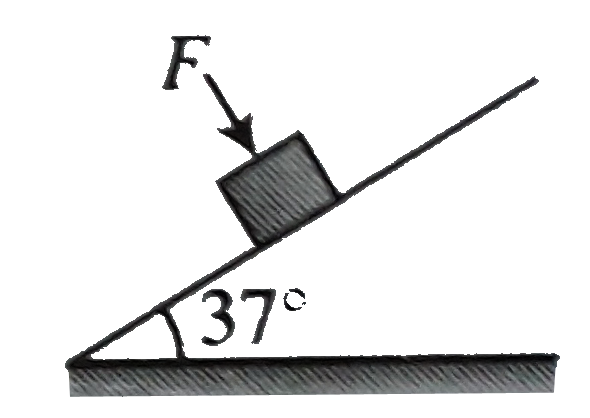A block of mass 2 kg slides on an intļined plane which makes an angle of 30 with the horizontal. The : efficient of friction between the block and the surface is √(3/2)
(a) What force should be applied to the block, so that the block moves down without any acceleration?
(b) What force should be applied to the block, so that it moves up without any acceleration ?
(c) Calculate the ratio of the powers needed in the above two cases, if the speed of block is same in both the cases.
Here fL=μR=μmgcosθ=μmgcosθ=√3/2×2×g×(√3/2)=3g√2
and component of weight alone the plane
mgsinθ=2×g×(12)=g
(a) As mgsinθ<fL, the block will remain at rest on the plane and so to move it down the plane force F mu be applied parallel to the plane downwards as in figure (a).

So, equation of motion down the plane will be
(FD+mgsinθ)−fL=ma
orFD+2g12=g3√2 [asv=constant so,a=0]
orFD=(3−√2√2)g=11N
(b) if FU is the force required to move the block up the plane, the equation of motion will be
Fυ−(fL+mgsinθ)=ma
orFυ=2g12+g3√2[as v = constant so,a = 0]
orFυ=(3+√2√2)g=30.6N
(c) As power =(force)×(velocity)
So,PDPU=FDvDFυvυ=fDFυ [as vD=vυ]
i.e.,PDPυ=[3−√23+√2]=0.36
Similar Questions
A block of mass 2 kg rests on an inclined plane which makes an angle of 30∘ with the horizontal. The coefficient of friction between the block and the surface is √3/2. (i) What force should be applied on the block so that it moves down without any acceleration ? (ii) What force should be applied on the block so that it moves up without any acceleration ? (iii) Calculate the ratio of the powers in the above two cases if the block moves with uniform speed in both the cases.
View SolutionA block of mass 2 kg rests on an inclined plane which makes an angle of 30∘ with the horizontal. The coefficient of friction between the block and the surfcae is √3/2. (i) What force should be applied on the block so that it moves down without any acceleration ? (ii) What force should be applied on the block so that it moves up without any acceleration ? (iii) Calculate the ratio of the powers in the above two cases if the block moves with uniform speed in both the cases.
View Solution
Knowledge Check
A block rests on a rough inclined plane making an angle of 30∘ with the horizontal. The coefficient of static friction between the block and the plane is 0.8. If the frictional force on the block is 10N, the mass of the block (in kg) is
A(a) 1.6B(b) 4.0C(c) 2.0D(d) 2.5
A block of mass 2 kg rests on a rough inclined plane making an angle of 30° with the horizontal. If μS=0.6 , what is the frictional force on the block ?
View SolutionA block rests on a rough inclined plane making an angle of 30∘ with the horizontal. The coefficient of static friction between the block and the plane is 0.8. If the frictional force on the block is 10N, the mass of the block (in kg) is
View SolutionA block slides down an inclined plane that makes an angle θ with the horizontal. If the coefficient of kinetic friction is μ, find the acceleration of the block.
View SolutionA block of mass m=2kg is resting on a inclined plane of inclination 30∘ The coefficient of friction between the block and the plane is μ=0.5 what minimum force F (in newton) should be applied perpendicular to the plane on the block so that the does not slip on the plane?

View SolutionWhat force should be applied on the wedge so that block over it does not move? (All surfaces are smooth)

View SolutionWhat force should be applied on the wedge so that block over it does not move? (All surfaces are smooth)

View SolutionA block slides down a frictionless, inclined plane that makes a 30∘ angle with the horizontal. Find the acceleration of this block.
View Solution
